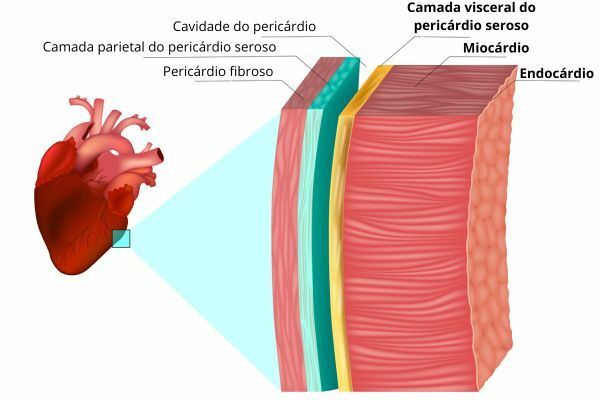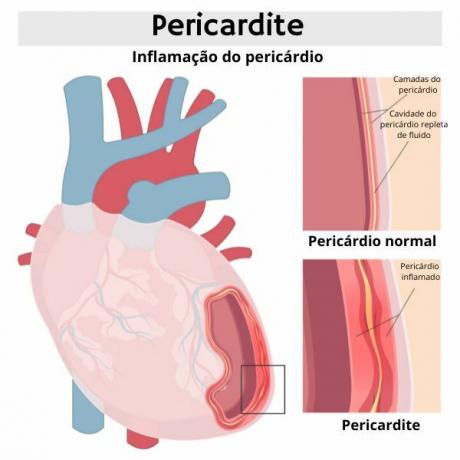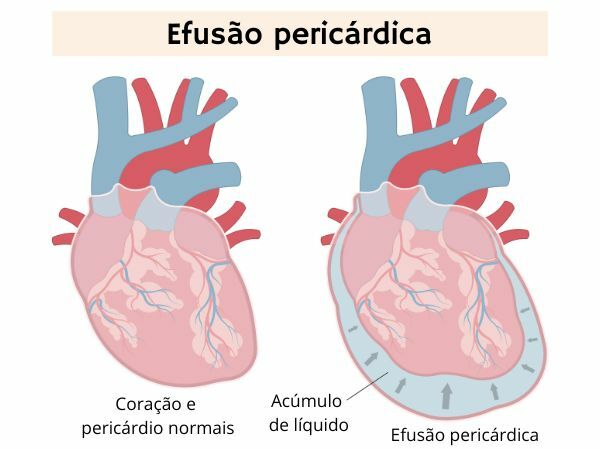Pericardium It is a fibroserous sac formed by connective tissue that surrounds the heart and great vessels. It is made up of two layers, called fibrous and serous, which surround and protect the heart against friction during contraction movements.
The serous pericardium is also formed by two layers, a parietal layer, more external, and another visceral layer, internal. Between these two layers there is the pericardial cavity, which contains the pericardial fluid, responsible for lubricating the pericardial structures and reducing friction during movements of contraction of heart.
Read too: Aorta — all about the largest artery in the human body
Topics in this article
- 1 - Summary of the pericardium
- 2 - What are the functions of the pericardium?
- 3 - Location of the pericardium
- 4 - Anatomy of the pericardium
- 5 - Diseases of the pericardium
Summary about the pericardium
- The pericardium is a fibroserous sac that surrounds the heart and the roots of the great vessels.
- It is made up of two layers: a fibrous layer, called the fibrous pericardium, and a serous layer, called the serous pericardium.
- The serous pericardium, in turn, is also divided into two layers: parietal and visceral.
- Between the parietal and visceral layers is the pericardial cavity, which contains pericardial fluid.
- The pericardium provides limits to the extension of the heart, preventing its excessive dilation.
- The pericardium functions as a mechanical barrier, protecting the heart against infections.
- Pericarditis and pericardial effusion are diseases that affect the pericardium.
What are the functions of the pericardium?
The pericardium keeps the heart in a stable position within the mediastinum (region of the chest located between the lungs), separating it from other structures present there. The pericardium limits the movement of the heart and also provides a lubricated surface that helps the heart beat.
Do not stop now... There's more after the advertising ;)
Furthermore, the pericardium prevents excessive dilation of the heart and influences the pressure exerted on the heart chambers, as it sets limits for the heart to increase in volume. This structure also functions as a mechanical barrier, protecting the heart against infections.
Read too: After all, what is a heart attack?
Location of the pericardium
The pericardium is located in the mediastinum region, which is located in the midline of the body and which contains all the structures of the thorax, with the exception of the lungs. The pericardium is attached to the heart, surrounding it and separating it from other structures present in the mediastinum.

Anatomy of the pericardium
The pericardium is a fibroserous sac formed by two layers, a fibrous layer and a serous layer. The fibrous pericardium is the outer layer of the pericardium that has its apex fused with the roots of the large vases, and its base is fused to the central tendon of the diaphragm. Furthermore, it is connected to the sternum through ligaments that connect it to this region.
The serous pericardium is the inner layer of the pericardium, which is made up of two other layers: an external parietal layer, which is in contact with the fibrous pericardium, and a visceral layer, arranged more internally, that covers the heart and the roots of the great vases. Furthermore, the region of the visceral layer that covers the heart but does not cover the vessels is called epicardium. Between the parietal and visceral layers is the pericardial cavity, which contains pericardial fluid.

Pericardium diseases
Among the diseases that affect the pericardium, we can mention those that generate changes in the capacity of this structure to protect and assist the heart's movements.
A Pericarditis, for example, is an inflammation of the pericardium caused by infections, immunological problems or changes in metabolism that can generate symptoms such as fever and pain in the central region of the chest, which increases when the individual lies down and decreases when he or she lies down. sit down.

A pericardial effusionis another disease related to the pericardium, generated by excessive accumulation of fluid in the pericardial space. Under normal conditions, the pericardium contains a few milliliters of pericardial fluid, which has a lubricating action. But pericarditis, and other conditions, can lead to fluid buildup, leading to heart failure.

Sources
COELHO, C. Evaluation of lesions and bacterial agents causing pericarditis in pigs. Available in:
https://lume.ufrgs.br/bitstream/handle/10183/29064/000775137.pdf? sequence=1&isAllowed=y.
REHMA, I.; NASSEREDDIN, A.; REHMA, A. Anatomy, Thorax, Pericardium. Available in: https://www.ncbi.nlm.nih.gov/books/NBK482256/.
SOUZA, S. Pericardial effusion in dogs and cats: literature review. Available in: https://bdm.unb.br/handle/10483/22416.
Would you like to reference this text in a school or academic work? Look:
SOZZA, Nicole Fernanda. "Pericardium"; Brazil School. Available in: https://brasilescola.uol.com.br/biologia/pericardio.htm. Accessed on November 9, 2023.

Pre-Enem Class 2023: 1st day of test
Excited for the first day of the Enem 2023 exams? Our team of teachers will help you, with special tips, to...
